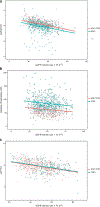Mineral bone disease in autosomal dominant polycystic kidney disease
- PMID: 32926884
- PMCID: PMC7993988
- DOI: 10.1016/j.kint.2020.07.041
Mineral bone disease in autosomal dominant polycystic kidney disease
Abstract
Mice with disruption of Pkd1 in osteoblasts demonstrate reduced bone mineral density, trabecular bone volume and cortical thickness. To date, the bone phenotype in adult patients with autosomal dominant polycystic kidney disease (ADPKD) with stage I and II chronic kidney disease has not been investigated. To examine this, we characterized biochemical markers of mineral metabolism, examined bone turnover and biology, and estimated risk of fracture in patients with ADPKD. Markers of mineral metabolism were measured in 944 patients with ADPKD and other causes of kidney disease. Histomorphometry and immunohistochemistry were compared on bone biopsies from 20 patients with ADPKD with a mean eGFR of 97 ml/min/1.73m2 and 17 healthy individuals. Furthermore, adults with end stage kidney disease (ESKD) initiating hemodialysis between 2002-2013 and estimated the risk of bone fracture associated with ADPKD as compared to other etiologies of kidney disease were examined. Intact fibroblast growth factor 23 was higher and total alkaline phosphatase lower in patients with compared to patients without ADPKD with chronic kidney disease. Compared to healthy individuals, patients with ADPKD demonstrated significantly lower osteoid volume/bone volume (0.61 vs. 1.21%) and bone formation rate/bone surface (0.012 vs. 0.026 μm3/μm2/day). ESKD due to ADPKD was not associated with a higher risk of fracture as compared to ESKD due to diabetes (age adjusted incidence rate ratio: 0.53 (95% confidence interval 0.31, 0.74) or compared to other etiologies of kidney disease. Thus, individuals with ADPKD have lower alkaline phosphatase, higher circulating intact fibroblast growth factor 23 and decreased bone formation rate. However, ADPKD is not associated with higher rates of bone fracture in ESKD.
Keywords: ADPKD; bone; mineral metabolism.
Copyright © 2020 International Society of Nephrology. Published by Elsevier Inc. All rights reserved.
Figures


References
-
- Torres VE, Harris PC, Pirson Y. Autosomal dominant polycystic kidney disease. Lancet. 2007;369:1287–1301. - PubMed
-
- Ong AC, Devuyst O, Knebelmann B, Walz G, ERA-EDTA Working Group for Inherited Kidney Diseases. Autosomal dominant polycystic kidney disease the changing face of clinical management. Lancet. 2015;385: 1993–2002. - PubMed
-
- Geng L, Segal Y, Pavlova A, et al. Distribution and developmentally regulated expression of murine polycystin. Am J Physiol. 1997;272:F451–F459. - PubMed
-
- Mochizuki T, Wu G, Hayashi T, et al. PKD2, a gene for polycystic kidney disease that encodes an integral membrane protein. Science. 1996;272: 1339–1342. - PubMed
Publication types
MeSH terms
Substances
Grants and funding
LinkOut - more resources
Full Text Sources
Other Literature Sources
Medical
Research Materials
Miscellaneous

